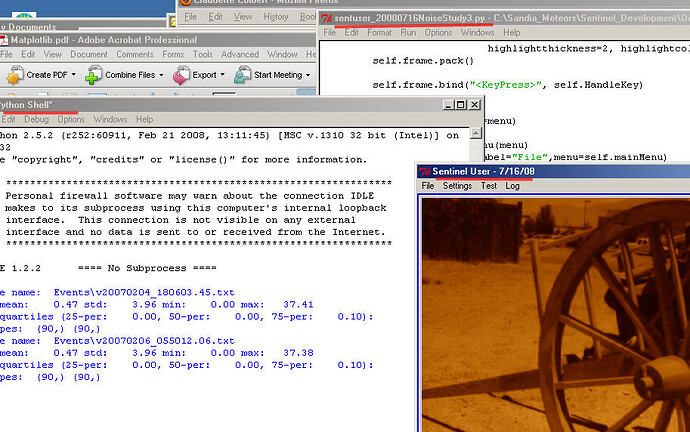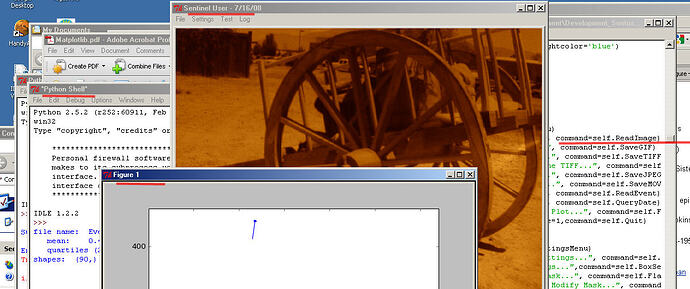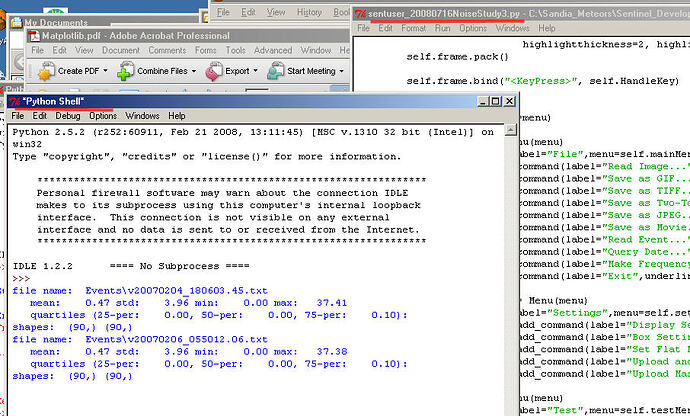Wayne Watson wrote:
The developer stated this in a msg this morning.
Either way should work. Double clicking the py file is probably more convenient, but you can more easily see error messages if you open it with IDLE
option 3:
Start it up in a command window (DOS box on Windows), and then you won't have the mainloop interaction issues, and you'll see the output.
open a dos box, cd to the directory where your script is, and type:
python name_of_script.
If it can't find python, then you need to tell it where to look by adding it to your PATH or typing the whole thing:
C:\Python25\bin\python.exe
or something like that (not on Windows at the moment)
Note that this is not an MPL issue it is an IDLE (and many other IDEs) issue -- any Python IDE that runs your code in the same process as the IDE itself is going to have these issues.
IPython has gone to great pains to make interactive use with GUI programs work -- I don't any other tool that has.
Wayne Watson wrote:
That link has no reference to tkinter. tk and tk2, plus a few others with tk in their names, but nothing else.A search in the box produced nothing.
tkinter is the python binding to the Tk GUI toolkit -- so tkiniter and tk mean about the same thing when talking about Python.
Wayne Watson wrote:
Thanks for the info. I'm semi-resistant to ipython. I tried if for a few hours, and it seemed a bit too much like linux.
ipython is an interactive command line interface to Python -- it is much nicer than the raw interpreter, but it is what it is, and it is very good at it. It can be very helpful to experiment with stuff in an interactive environment, but once you go beyond tiny stuff, you need to write a program. To do that you need an editor, and a wya to run and debug it. An IDE integrates these functions, and there are many of them.
Personally, I use an editor to edit the code, the commend line (or IPython) to run the code, and do most of my debugging with print statements.
I suggest you take a bit of a break from the problem at hand, and go through a couple intro tutoroal sit python, write a couple small programs (tkinter-based, if that's what you're going to need), and get a handle on how to do it.
lot, and enjoyed it. I'll consider it. Windows is the game now.
frankly, not all that different from a programming in Python point of view.
Yes, actual use is good, but the needed imports seem a bit baffling. scipy, pylab, matplotlib, ...? What components do I only need for a particular use?
you need what you need -- you need numpy for amost eveything you'll ever do if you work with numbers. You need matplotlib if you need to plot, you need scipy if you need any of the more complicated numerical routines it provides. pyplot dumps a bunch of these into the same namespace, which is nice for interactive use, but I"d stay away from it for writing programs.
Wayne Watson wrote:
I'm assuming that I don't
want to use import matplotlib a lot, but something selectively like from matplotlib.image import AxesImage, or from matplotlib.plot import figure, show. What did I miss in my Python upbringing?
It's really a matter of taste. YOu either do:
import matplotlib
fig = matplotlib.figure
or from matplotlib import figure
fig = figure.
You'll need a lot of things in matplotlib if you're doing much of anything, and "namespaces are one honking great idea", so I do:
import matplotlib as mpl
fig = mpl.figure()
etc..
HTH,
-Chris
···
--
Christopher Barker, Ph.D.
Oceanographer
Emergency Response Division
NOAA/NOS/OR&R (206) 526-6959 voice
7600 Sand Point Way NE (206) 526-6329 fax
Seattle, WA 98115 (206) 526-6317 main reception
Chris.Barker@...259...


